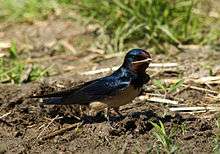Hirundo
The bird genus Hirundo is a group of passerines in the family Hirundinidae (swallows and martins). The genus name is Latin for a swallow.[1] These are the typical swallows, including the widespread barn swallow. Many of this group have blue backs, red on the face and sometimes the rump or nape, and whitish or rufous underparts. With fifteen species this genus is the largest in its family.
| Hirundo | |
|---|---|
 | |
| A barn swallow collecting nest material in Germany | |
| Scientific classification | |
| Kingdom: | Animalia |
| Phylum: | Chordata |
| Class: | Aves |
| Order: | Passeriformes |
| Family: | Hirundinidae |
| Subfamily: | Hirundininae |
| Genus: | Hirundo Linnaeus, 1758 |
| Species | |
|
See text | |
Taxonomy
Genetic evidence has recently shown that many of the species previously included in Hirundo are less closely related than their appearance might suggest; these species are sometimes treated in the separate genera Cecropis (e.g. red-rumped swallow Cecropis daurica, previously Hirundo daurica) and Petrochelidon (e.g. cliff swallow Petrochelidon pyrrhonota, previously Hirundo pyrrhonota); they are as distinct from typical Hirundo as the house martins in the genus Delichon.
Extant species
The genus contains fifteen species:[2]
- Barn swallow (Hirundo rustica)
- Red-chested swallow (Hirundo lucida)
- Angolan swallow (Hirundo angolensis)
- Pacific swallow (Hirundo tahitica)
- Hill swallow (Hirundo domicola)
- Welcome swallow (Hirundo neoxena)
- White-throated swallow (Hirundo albigularis)
- Ethiopian swallow (Hirundo aethiopica)
- Wire-tailed swallow (Hirundo smithii)
- Blue swallow (Hirundo atrocaerulea)
- White-bibbed swallow (Hirundo nigrita)
- Pied-winged swallow (Hirundo leucosoma)
- White-tailed swallow (Hirundo megaensis)
- Black-and-rufous swallow (Hirundo nigrorufa)
- Pearl-breasted swallow (Hirundo dimidiata)
Extinct species
There are at least two fossil species included in this genus:
Former species
Some authorities, either presently or formerly, recognize several additional species as belonging to the genus Hirundo including:
- West African swallow (as Hirundo domicella)[4]
Distribution and habitat
All of the species are found in the Old World, although one, the barn swallow, is cosmopolitan, also occurring in the Americas.
Gallery

H. rustica foraging 
Windows in the tail of H. rustica 
Tail streamers of H. smithii filifera Nest of H. rustica Clutch of H. rustica gutturalis 
Clutch of H. smithii
References
- Jobling, James A (2010). The Helm Dictionary of Scientific Bird Names. London: Christopher Helm. p. 193. ISBN 1408125013.
- Gill, Frank; Donsker, David, eds. (2017). "Swallows". World Bird List Version 7.2. International Ornithologists' Union. Retrieved 2 June 2017.
- Kessler, E. (2013). Neogene songbirds (Aves, Passeriformes) from Hungary. Hantkeniana Budapest 8: 37-149.
- "Cecropis domicella - Avibase". avibase.bsc-eoc.org. Retrieved 2017-05-05.
| Wikimedia Commons has media related to Hirundo. |